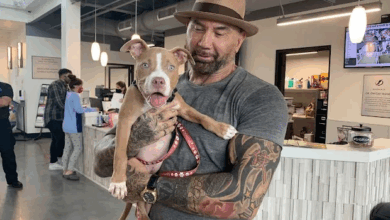
Imagine your furry friend wagging their tail with excitement as you pour them a bowl of delicious, nutritious, and healthy dog food. Choosing the right food for your pup can be overwhelming, but it’s essential to ensure they live a healthy and happy life.
With so many options available, it’s crucial to know what to look for when selecting healthy dog food. In this article, we’ll guide you through the process of choosing the best dog food for your four-legged companion.
We’ll cover everything from understanding nutritional content to avoiding common health concerns and choosing the right type of food. By following these tips, you can rest assured that you’re providing your furry friend with the nourishment they need to thrive.
So let’s get started!
Consider Your Dog’s Nutritional Needs
You’ll want to make sure you’re choosing a dog food that meets all of your furry friend’s nutritional needs! The first step in doing so is to choose the right protein for your pup. Dogs are carnivores, which means that they need high-quality animal protein in their diets. Look for dog food with a named meat source as the first ingredient, such as chicken or beef. This will ensure your dog gets the essential amino acids they need to build and repair muscles.
Consulting with an expert can also help you determine what type of dog food will best meet your pet’s nutritional needs. A veterinarian or animal nutritionist can provide guidance on what nutrients are most important, based on factors like breed, age, and activity level. They may recommend a specific brand or type of food that is tailored to your pup’s unique needs.
Once you’ve chosen a protein source and consulted with an expert, it’s time to read the ingredient list carefully. This will give you an idea of what else is included in the dog food and whether it contains any fillers or artificial additives.
By taking these steps, you’ll be well on your way to selecting a healthy and nutritious diet for your furry friend!
Read the Ingredient List
When scanning the ingredient list, it’s like reading a map – you want to see recognizable landmarks (like chicken or rice) rather than unfamiliar territory. Ingredient quality and sourcing are critical in choosing healthy dog food. High-quality ingredients mean better nutrition for your furry friend. Avoid foods that contain ‘meal’ or ‘by-product’ as these terms indicate lower quality proteins and other ingredients.
In addition to ingredient quality, be mindful of artificial additives and preservatives. Chemicals like BHA, BHT, and ethoxyquin can cause health problems in dogs over time. Look for natural preservatives like tocopherols (vitamin E) instead. Artificial coloring agents have no nutritional value and may even cause allergic reactions in some dogs.
Understanding the nutritional content of your dog’s food is essential to making an informed decision about their diet. Next up we’ll discuss how to evaluate this information on a pet food label so that you can make sure your pup is getting all the nutrients they need to grow strong and stay healthy.
Understand Nutritional Content

Don’t let your furry friend miss out on the essential nutrients they need to thrive – understanding nutritional content is key.
When choosing a dog food, you must consider the macronutrient balance and digestibility factors. The three main macronutrients are protein, carbohydrates, and fats.
It’s important to choose a dog food that has a good balance of these macronutrients for your pup’s overall health. Protein is essential for muscle growth and repair, as well as maintaining healthy skin and coat. Carbohydrates provide energy for dogs to play and exercise while fat helps with insulation and absorption of vitamins.
When reading the nutritional label, make sure that the protein source is clearly identified, such as chicken or beef instead of generic terms like ‘meat’ or ‘animal by-products.’
Digestibility factors also play an important role in choosing healthy dog food. Some ingredients can be difficult for dogs to digest leading to digestive issues such as vomiting or diarrhea. Look for easily digestible ingredients such as brown rice or sweet potatoes rather than fillers like corn or wheat which may cause stomach upset.
Understanding nutritional content is vital when it comes to picking out healthy dog food for your pet. By considering the macronutrient balance and digestibility factors, you can ensure that your furry friend receives all the necessary nutrients needed to thrive without experiencing any health concerns down the line.
In order to avoid common health concerns further, there are additional steps you should take when selecting your pet’s diet.
Avoid Common Health Concerns
Pet parents, prevent potential problems by picking products that promote proper pup health. It’s important to avoid common misconceptions about dog food ingredients and sourcing.
Many dog foods contain fillers like corn or wheat, which can lead to allergies or digestive issues in some dogs. Instead, look for high-quality protein sources like chicken, beef, or fish as the main ingredient.
Ingredient sourcing is also an important consideration when choosing healthy dog food. Look for products made with locally sourced ingredients and produced in facilities with strict quality control measures. This can help ensure that your dog’s food is free from harmful additives and contaminants that can lead to health problems down the line.
By avoiding common health concerns associated with poor nutrition and ingredient sourcing, you’ll be on your way to choosing a healthy diet for your furry friend.
Next up, we’ll discuss how to choose the right type of food based on your dog’s specific needs and preferences.
Choose the Right Type of Food
When it comes to choosing the right type of food for your dog, you have a few options to consider. Dry food is a popular option due to its convenience and affordability, but it’s important to choose one that contains high-quality ingredients.
Wet food can be a good choice for dogs who need more moisture in their diet or have dental issues, but it can also be more expensive.
Raw food diets are becoming increasingly popular, but they require careful planning and preparation to ensure your dog gets all the necessary nutrients.
Ultimately, the best choice depends on your individual dog’s needs and preferences.
Dry Food
One important factor to consider when selecting healthy dog food is the quality of ingredients used in dry food. Dry food has many benefits for your furry friend, such as promoting dental health and being more convenient for storage. However, not all dry foods are created equal.
Look for high-quality protein sources, like chicken or beef, and avoid fillers like corn or wheat. When transitioning to a new dry food, it’s important to do so gradually over several days to prevent digestive upset. Start by mixing the new food with the old food in small amounts and gradually increase the ratio of new to old over time.
Watch your dog closely during this transition period and consult with your veterinarian if you notice any unusual behavior or symptoms. As you consider different types of dog foods, keep in mind that wet food can also be a healthy option for your pup.
Wet Food
You might think that wet food is only for spoiled dogs, but it can actually be a great addition to your pup’s diet. Here are some benefits of incorporating wet food into your dog’s meals:
- Hydration: Wet food contains more water than dry kibble, so it can help keep your dog hydrated and prevent urinary tract infections.
- High-quality protein: Many high-quality wet foods contain more animal-based protein than plant-based fillers, which means they provide the amino acids necessary for muscle growth and repair.
- Variety: Wet food comes in many flavors and textures, which can make mealtime more exciting for your furry friend.
If you want to switch from dry to wet food, it’s important to do so gradually over a week or two. Start by mixing a small amount of wet food with your dog’s dry kibble and gradually increase the proportion until you’re feeding 100% wet food. This will help prevent digestive upset.
Now that you know about the benefits of wet food and how to transition your pup, let’s dive into another option: raw food diets.
Raw Food
If you’re looking to give your furry friend a nutrient-rich and natural diet, consider incorporating raw food into their meals. Raw feeding is becoming increasingly popular amongst dog owners who are seeking to provide their pets with a more biologically appropriate diet.
The benefits of raw feeding include improved digestion, healthier skin and coat, stronger immune system, and better dental health. However, it’s important to note that there are also some safety concerns associated with raw feeding.
Raw meat can contain harmful bacteria such as Salmonella or E. coli which can be dangerous for both dogs and humans. It’s crucial to handle raw food properly by washing hands thoroughly after handling it, keeping the food in the fridge or freezer until ready to serve, and sanitizing all surfaces that come into contact with the meat.
When considering your budget for your pet’s diet, take into account the added cost of purchasing high-quality raw ingredients and any necessary supplements to ensure a balanced diet.
Consider Your Budget
When considering the right type of dog food for your furry friend, it’s important to factor in your budget.
You’ll want to not only look at the price per serving but also consider the quality versus cost.
It’s possible to find a healthy and affordable option that meets both standards.
Price per Serving
Typically, higher-quality dog foods with better ingredients will have a higher price per serving. Balancing quality and price is important when choosing healthy dog food. However, it’s important to note that finding affordable options doesn’t necessarily mean sacrificing quality. It’s possible to find high-quality dog foods at reasonable prices if you know where to look.
It’s also worth considering the long-term cost of feeding your dog a lower-quality diet. Poor nutrition can lead to health problems down the line, which may end up costing more in vet bills and medication than investing in a higher quality dog food from the start.
When choosing a healthy dog food, it’s essential to weigh both the immediate cost and potential long-term benefits for your furry friend. With this in mind, let’s explore how to balance quality and cost when selecting a healthy diet for your pup.
Quality vs. Cost
You may feel torn between your desire to provide your furry companion with the best possible nutrition and your concerns about the cost of high-quality dog food. It’s understandable; after all, organic options and brands that have a good reputation come with a higher price tag.
However, it’s important to consider the long-term benefits of investing in quality dog food for your pet’s health. One way to determine if a brand is worth the extra expense is by researching their ingredients. Look for brands that use whole meats, fruits, and vegetables as their primary ingredients instead of fillers like corn or wheat.
Additionally, consult with your veterinarian about which brands they recommend based on your dog’s specific needs. With some careful consideration, you can find a balance between quality and cost when choosing the best food for your furry friend.
Consult with Your Veterinarian
To ensure your pup is receiving the proper nutrition, it’s best to consult with your vet about selecting healthy dog food. Your veterinarian can provide you with expert advice on what type of diet will be best suited for your furry friend.
They may recommend specialty diets for specific conditions or suggest homemade options that can cater to your dog’s unique needs. It’s important to keep in mind that not all dogs have the same nutritional requirements. Factors such as age, breed, and health condition can influence what type of food is appropriate for them.
Regular check-ups with your vet are crucial in ensuring that your pet is getting all the necessary nutrients they need to thrive. Additionally, consulting with your veterinarian can help you avoid any potential health risks associated with certain types of dog food.
You’ll be able to identify any ingredients that may trigger an allergic reaction or cause digestive problems for your pet. By working closely with a veterinary professional, you’ll have peace of mind knowing that you’re providing the best possible care for your furry companion.
Conclusion
Well done, you’ve successfully navigated the complex world of dog food selection. You’ve considered your furry friend’s nutritional needs, read through ingredient lists, and understood the nutritional content of different options. You’ve also been mindful of common health concerns and choose the right type of food for your pup.
But wait! There’s one more thing to consider: your budget. Don’t worry though, because we all know that healthy dog food is affordable for everyone…just kidding! In reality, healthy dog food can be quite expensive, but there are ways to make it work within your budget.
One option is to look for deals or coupons online or in-store. Another option is to buy in bulk or switch between brands when they go on sale. And don’t forget about consulting with your veterinarian who may have recommendations based on their expertise and experience.
In conclusion, choosing healthy dog food requires careful consideration and research but ultimately leads to a happy and healthy pup. Just remember that despite what some may say, feeding your canine companion high-quality food doesn’t mean you have to break the bank – it just means being resourceful and strategic with your purchases.
So go forth with confidence knowing that you’ve got this handled like a pro!
Read more:


















































